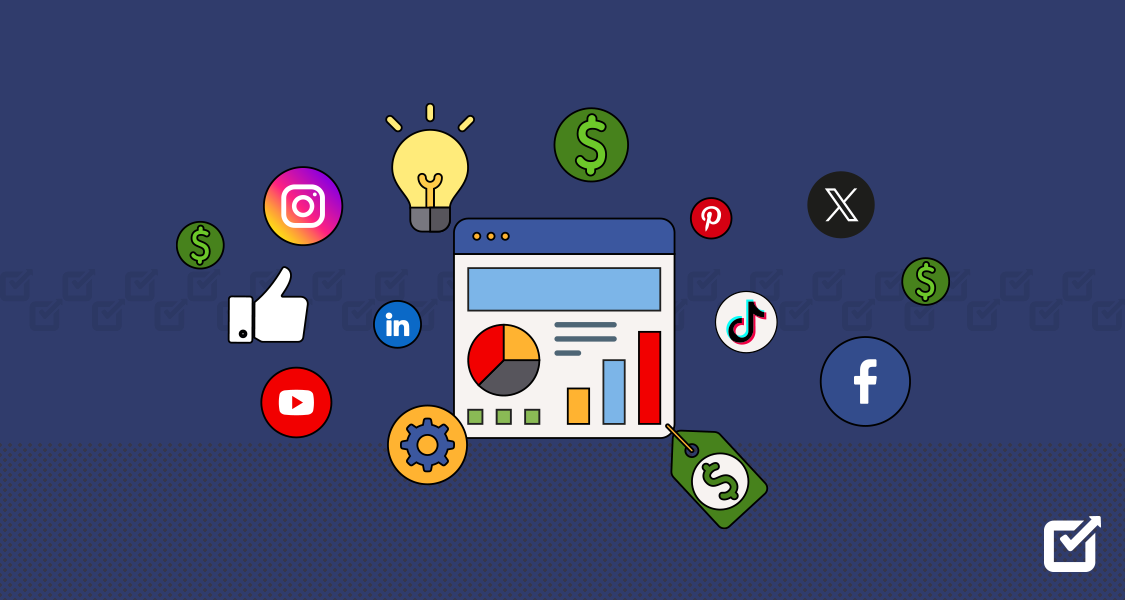If you’ve been hanging around the social media water cooler (or should we say, TikTok dance studio?), you’ve probably noticed some wild new trends shaking up the influencer scene. From Instagram Reels that pack a punch in 15 seconds to the Twitter (sorry, X) threads that drop truth bombs faster than you can say “retweet,” this year’s influencer game is evolving faster than AI can write your next blog post.
But don’t worry because we’re here to spill the tea on what’s working in 2024. Whether you’re a seasoned social media manager or just trying to wrap your head around social media management tools, we’ve got you covered.
Let’s explore the world of sponsored posts, quirky collaborations, and the influencers who are making it happen across the most popular social media platforms.
Automate All Popular Social Media Platforms With Social Champ!
Our cutting-edge technology lets you plan, create, schedule, and analyze content for up to 10 platforms!
What Are the Most Popular Social Media Platforms for Influencer Marketing
Here are the most popular social media platforms that are everything you need to conquer the digital marketing:
Instagram: The Reigning Queen
Instagram is still at the top of influencer marketing. With over 2 billion monthly active users, it’s a playground for influencers of all shapes and sizes.
So, why does Instagram continue to rule the influencer marketing world? First, it’s all about Reels. Short, punchy, and entertaining, Instagram Reels are giving TikTok a run for its money. Influencers are leveraging them to deliver quick bites of brand magic that resonate with their audiences. But don’t count out carousels just yet—posts with multiple images or videos are killing it with engagement rates. Influencers are creating mini-stories with each swipe, making them perfect for brand storytelling.
While Reels have certainly stolen the spotlight, Instagram Stories still shine, remaining a go-to for behind-the-scenes content, Q&As, and polls. The ability to add stickers, music, and interactive elements keeps Stories fresh and engaging, providing a personal touch that deepens the influencer-audience connection.
If you’re a brand, don’t just focus on the big names with millions of followers. Leveraging micro-influencers- those with 10,000 to 100,000 followers, can offer authentic connections with niche audiences.
You can further encourage them to create user-generated content (UGC) that you can repost, which can help you reach a wider audience in a genuine way. And for a fun twist, partner with influencers to create branded AR filters that their followers can use and share.
TikTok: The New Kid on the Block
If Instagram is the queen, TikTok is the cool new kid that everyone wants to hang out with. With 1.5 billion users worldwide, TikTok is all about creativity, authenticity, and snappy storytelling.
What makes TikTok the ultimate influencer playground? Its short-form videos are a goldmine for keeping attention spans hooked. Bite-sized videos of up to three minutes long allow influencers to get creative, delivering content that’s often humorous, heartfelt, or downright quirky.
The trend-driven nature of the platform means that influencers are experts at hopping on the latest viral sounds and hashtags, making their branded content blend seamlessly with the organic trends users love.
Moreover, TikTok is a direct line to audiences. The algorithm serves up content based on users’ interests rather than their follower lists, making it a fertile ground for influencers to reach new audiences beyond their current followers. This has enabled the rise of everyday creators who are turning their TikTok followings into full-blown influencer careers.
For brands wanting to make an impact on TikTok, it’s essential to think creatively. Partner with influencers who embody your brand’s vibe and give them the creative freedom to incorporate your products naturally. Unpolished, authentic content wins hearts here, so lean into the fun and embrace the quirky side of influencer marketing.
YouTube: The Long-Form Maestro
YouTube remains a powerhouse for long-form content and continues to be a significant platform for influencer marketing. With over 2 billion monthly active users, it’s the go-to for in-depth product reviews, tutorials, and vlogs.
YouTube influencers, or “YouTubers,” excel at building trust with their audiences through long-form storytelling. Whether it’s unboxing the latest tech gadget, sharing beauty tutorials, or giving travel tips, their ability to dive deep into topics makes them a valuable resource for brands looking to showcase their products in detail.
Collaborating with YouTubers allows brands to engage with audiences through sponsored segments, dedicated product reviews, and even branded series. But it’s not just about paid partnerships—leveraging user-generated content and working with micro-YouTubers (10,000 to 100,000 subscribers) can also yield impressive results.
Twitter (or X): Where Conversations Ignite
Twitter might have rebranded as X, but it’s still a platform where conversations ignite. Influencers here are known for their hot takes, quick wit, and ability to drive trending conversations.
Whether it’s live-tweeting an event, dropping snappy product endorsements, or leading informative threads, influencers on X are adept at creating engaging content that encourages retweets and replies. It’s a great platform for thought leaders and industry experts to establish themselves as authorities in their niches.
Brands can benefit from partnering with influencers to host Twitter Spaces, creating hashtag campaigns, and running polls to generate buzz. And don’t underestimate the power of those 280 characters—a clever tweet can quickly go viral and put your brand in front of millions.
LinkedIn: The Professional Powerhouse
LinkedIn has transformed into a thriving hub for B2B influencer marketing. Influencers on this platform, often called “thought leaders,” are known for their expertise in specific industries and their ability to generate insightful discussions.
In 2024, LinkedIn influencers are driving conversations around leadership, innovation, and industry trends. They’re sharing thought-provoking articles, videos, and posts that resonate with professionals looking for solutions to business challenges.
Brands targeting a professional audience can collaborate with LinkedIn influencers to create content like case studies, white papers, and webinars. By positioning influencers as brand advocates, companies can enhance their credibility and reach decision-makers more effectively.
Related Article: Social Media Intelligence: What it Is and Why You Need it?
A Mix of the Most Popular Social Media Platforms
In 2024, the influencer marketing landscape is as diverse as ever. Instagram, TikTok, YouTube, X (formerly Twitter), and LinkedIn each offer unique opportunities to tell your brand story and to use their potential truly, you need a cohesive, cross-platform approach.
Understand Your Goals and Audience: Before diving into content creation, define your campaign goals. Are you aiming for brand awareness, lead generation, or direct sales? Understanding your audience’s demographics and preferences will guide your platform mix. For instance, Gen Z and Millennials might be more active on TikTok and Instagram, while LinkedIn is a powerhouse for B2B marketing.
Develop Consistent Messaging Across Platforms: Your messaging needs to be consistent across platforms but tailored to fit each one’s unique style. Here’s a roadmap to mixing and matching your influencer content:
Launch Teasers and Build Hype
Start by partnering with influencers to generate buzz across multiple platforms. They can share teasers on Instagram Stories and Twitter (X) posts while hinting at an upcoming launch or special offer. Quick TikTok videos or YouTube Shorts can amplify this excitement, tapping into trending sounds or challenges.
Showcase Your Product’s Story
Influencers can then create in-depth, long-form content that digs into the product’s story. YouTube is perfect for tutorials, unboxings, and reviews, while LinkedIn thought leaders can write about how your product solves real-world business challenges. Instagram Reels and TikTok videos can highlight fun ways to use the product, making it relatable and accessible.
Encourage User Participation
Launch a challenge or campaign that encourages followers to participate and create their own content. TikTok challenges, Instagram Reels, and Twitter (X) threads are ideal for this. You can use branded hashtags to track engagement and showcase the best user-generated content (UGC) across your platforms. Influencers can help amplify this by sharing their audience’s posts, creating a snowball effect.
Live Engagement and Q&As
Host live sessions with your influencers on Instagram, YouTube, or LinkedIn to foster direct engagement. Whether it’s a Q&A, product demonstration, or casual chat, live sessions add an authentic touch. Record these sessions and repurpose highlights into short, engaging clips for TikTok and Instagram.
Repurpose and Recycle Content
Finally, leverage existing content across platforms to maximize reach. Turn Instagram Stories into TikTok videos, repurpose YouTube tutorials into LinkedIn posts, and convert TikTok challenges into Twitter threads. This helps reinforce your brand message consistently across different audiences.
Featured Article: Ultimate Guide on How to Use TikTok Live
Best Influencer Platforms for Creators
Social media creators are always on the lookout for tools and platforms that can enhance their content creation journey, ensuring high quality and engagement. Here are some of the best influencer platforms available:
influence.co
influence.co is a dedicated influencer marketing platform connecting creators with brands for meaningful collaborations. Influencers can create a professional profile showcasing their audience demographics, past collaborations, and content style. This makes it easier for brands to discover creators who align with their target audience and campaign goals.

influence.co Upfluence
Upfluence is a comprehensive influencer marketing platform that provides powerful search tools and actionable insights into audience demographics and interests. Creators can leverage this data to craft content that directly speaks to their viewers while easily managing collaborations.

Upfluence Aspire
Aspire stands out for its streamlined campaign management, allowing creators to connect with brands that align with their niche. By facilitating collaborations that resonate with both the creator’s and audience’s values, Aspire helps influencers produce high-quality, authentic content.

Aspire Trend
Trend connects creators with a network of peers and potential collaborators, offering fertile ground for creative ideas and high-quality content generation. Through Trend, creators can find brands that share their vision and engage in campaigns that resonate with their audiences.

Trend Traackr
Traackr is known for its influencer relationship management (IRM) capabilities, allowing creators to build and maintain valuable brand partnerships. With comprehensive analytics and tracking, creators can understand their audience better and deliver impactful campaigns.

Traackr
Conclusion
So, what’s working in influencer marketing in 2024? A lot, and on many different platforms. Instagram remains a powerhouse for visually engaging campaigns, TikTok delivers unmatched creativity, YouTube is ideal for long-form storytelling, X ignites conversations, and LinkedIn is a must for professional influence.
No matter which platform you choose, the key to successful influencer marketing is authenticity. Partner with influencers who genuinely align with your brand values, and let them do what they do best—create compelling, relatable content that resonates with their audiences.
Combining the strengths of Instagram, TikTok, YouTube, X, and LinkedIn into a unified influencer marketing strategy can significantly boost your brand’s reach and engagement in 2024. By understanding the unique nuances of most popular social media platforms and blending their strengths, you can create a cohesive, impactful campaign that resonates with your audience across the social media spectrum. So, grab that latte and start crafting your influencer marketing masterpiece.















